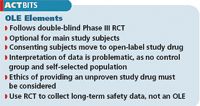Spotlight on Open-Label Extension Studies
Applied Clinical Trials
Open-label extension (OLE) studies are common, but they do not receive as much attention as traditional Phase I through Phase IV studies. Enrollment into an OLE study typically follows enrollment into a randomized, blinded, well-controlled main study. Participants are usually informed at the time they are recruited into the main study that they may elect to enroll in an OLE study after completing the main trial. The stated objective of most OLE studies is to obtain long-term safety and tolerability data.
Open-label extension (OLE) studies are common, but they do not receive as much attention as traditional Phase I through Phase IV studies. Enrollment into an OLE study typically follows enrollment into a randomized, blinded, well-controlled main study. Participants are usually informed at the time they are recruited into the main study that they may elect to enroll in an OLE study after completing the main trial. The stated objective of most OLE studies is to obtain long-term safety and tolerability data.
The use of OLE studies raises some important issues, which until recently have not been discussed. Articles by Wainwright1 and Taylor and Wainwright2 address some of these issues.

Interpretation challenges
Data collected as part of a clinical study are used in analyses that address the objectives of the study. The planned analyses are described in a statistical analysis plan, which includes sections on such topics as sample size, specifically defined endpoints, statistical methodology, specific duration of follow-up (as opposed to "until license approved" as seen in some OLE studies), and criteria for success. These topics are typically not well thought out and are even missing for OLE studies. Taylor2 suspects that these data are infrequently published.
For OLE studies, it is difficult to envision what analyses would be applicable without a control arm. A summary of the OLE study safety results is not easily interpretable without a comparator group. Even if some unexpected adverse events are seen, an epidemiological case is difficult to make against the active treatment since adverse events reported might be related to the long-term consequences of the disease under investigation, a separate disease or condition, or concomitant therapies rather than the active treatment.

ACTBITS
Judging OLE rates against rates from a registry such as the National Cancer Institute's SEER Program (Surveillance Epidemiology and End Results) is problematic since it is difficult to ensure that the populations are comparable. OLE efficacy data can only be presented descriptively, and comparisons with results from other situations—such as historical controls—are often not appropriate.
A data monitoring committee (DMC) can assess safety by comparing active arm to control arm in the main study, but it has no such tool for an OLE study. Therefore, safety risks are much harder to detect, despite DMC monitoring. The OLE study is generally longer than the main study, and to save costs participant visits are often less frequent. Thereby, the OLE study may impact safety without adding any useful information.
Caution should be exercised when combining main study data with OLE study data because the OLE population may differ from the main study population or the intended treatment population. Because entry into the OLE study is optional for the main study participants, there is self-selection bias. Subjects who participated in the main trial for a specific reason or reasons may, consciously or unconsciously, apply very different criteria to the decision to participate in an OLE study. Participants who withdrew consent (or died) during the main study would not be eligible for enrollment in the OLE study. Those who had adverse reactions (more likely in active or active control treatment arms, but also possible in a placebo arm) are less likely to enroll in the OLE study; whereas those who tolerated the treatment and/or had desirable outcomes during the main study are more likely to enroll.
In summary, the population in the OLE study is not representative of the entry criteria of the main study or the intended patient population.
Blinding concerns
Ethical concerns may conflict with the need to maintain blinding in the main study. It is standard practice for the participant (and investigative site and sponsor) to remain blinded to randomized treatment even when the participant is choosing whether to enroll in the OLE study. If, in fact, a participant was randomized to the control arm and had a desirable outcome, it may constitute an unnecessary risk to provide this participant with the open-label treatment. Conversely, if a participant was randomized to the active arm and had a poor result (and perhaps thinks, incorrectly, that they were on the control arm), it is again ethically questionable to allow this participant to enroll in the OLE study.
Obviously, any solution to this dilemma must not put the interpretation of the main trial results at risk, but a guided method of providing randomization assignment information to the participant before they elect to go into the OLE study would alleviate the risk of tainting the main trial results. One possibility1 is to have recruitment into the OLE study handled by an individual not involved with the main study. That individual could receive access to the participant's randomization assignment at the time of recruitment into the OLE study and discuss this as part of the informed consent process.
Coercive offer of active treatment
Although advocates for OLE studies emphasize that the OLE will allow all participants—even those initially randomized to the control arm—to receive active treatment, making the OLE study available to all main trial participants could easily be construed as a coercive practice. This could especially occur when this inducement is used as part of the marketing of the study to help recruitment. It is generally agreed that study participants should not receive excessive monetary inducements. For the same reasons, they should not be promised open-label treatment that they would not otherwise be able to obtain or afford. Some study participants may enter the main study for this "carrot" even if participation in the main study was not in their best medical interest.
It is well known that participants tend to overestimate the potential benefits of a new treatment and minimize its risks. Study organizers should approach a study with equipoise, meaning that they should espouse a reasonable belief that the efficacy of the active treatment could be the same as that of the control treatment, and that there is a potential for additional safety risks in the active treatment. The OLE study should not be used as an enticement for the main study. If a potential participant is eager for access to this new treatment and is therefore more likely to participate in the main study solely because of the opportunity to enroll in the subsequent OLE study, it may be easy and tempting for the clinical site to boost enrollment by silently acquiescing. Instead, sites must proactively and responsibly present the risks, benefits, and unknowns to all participants regardless of the effect on patient enrollment.
Long-term safety data
How can one address the need for additional safety data? The point is that the only way to obtain proper long-term safety data is to conduct a randomized controlled study of safety. Regulatory agencies should acknowledge this and not simply insist that a certain minimum number of years of patient exposure are required before approval. Instead, patient exposure should be meaningfully collected and analyzed.
If there is compelling evidence from earlier studies that the active treatment has superior efficacy and the decision is made that long-term safety data are needed, then at a minimum the OLE study should be an entirely separate Phase IV study. The control arm in such a study might not ethically be a placebo arm, but it could be an arm receiving the "standard of care," if one exists. The presence of a "standard of care" treatment arm could be critical, so potential study participants would be guaranteed some efficacious treatment, and the results would be interpretable by comparisons of the active therapy arm to the "standard of care" arm.
Such a well-controlled safety study does not have to cost that much more than an OLE study, as both types would potentially last for years. A well-controlled safety study would provide much more useful information than an OLE study and, in the long run, could not only protect study participants and potential consumers, but also the financial interests of the sponsor.
If excess risk truly exists, it will hopefully be detected earlier rather than later, after millions of patients have been treated, which potentially could result in a disastrous deluge of litigation. And if the risk is not excessive, a well-controlled safety study is powerful evidence to refute accusations based on anecdotal evidence or on inappropriate comparisons with historic information.
Open-label crossover studies
Many of the previous comments apply as well to a variant of the OLE study in which participants experiencing negative outcomes during the main study (e.g., a relapse or flare, disease progression, or a certain minimum change in outcome score) are immediately placed on open-label active treatment. This practice may be even more problematic than the OLE studies described, since it can seriously affect the interpretability of the main study.
A comparison of active treatment to control treatment at a specific final visit will be confounded because some participants randomized to control treatment receive active treatment. In essence, the active treatment will be compared against itself. So a potential treatment effect will be muted by these crossover subjects in this OLE variant.
Some studies in this case attempt to reconcile this difficulty by automatically assigning a result of "failure" for these subjects who cross into the open-label extension. This is only appropriate for a time-to-event analysis, where the question then answered is whether time to first negative result is delayed by the active treatment. In such a case, the criteria for switching to open-label treatment should be clearly delineated and be clinically relevant.
Such an imputation of "failure" would be inappropriate if the study was designed to evaluate outcome at some specific protocol-specified final visit. The negative outcome seen during the course of the main study could well be transitory with the participant having a positive outcome at the specific final visit.
If the primary endpoint is status at a specific final visit and some rescue treatment is truly deemed necessary in the case of a negative outcome before that time, then the participant should be offered "standard of care" rather than open-label active treatment. A potentially useful comparison is achieved: "active treatment plus ancillary standard of care" versus "control treatment plus ancillary standard of care."
Summary
In summary, OLE studies, despite being a standard addition to many well-controlled studies, need to be examined much more carefully to determine whether they are statistically meaningful and ethical. If OLE studies do not provide clinical insight or (more cynically) are done simply to get clinical sites accustomed to providing the new treatment in anticipation of regulatory approval, then this clearly is a problem that needs to be addressed.
References
1. P. Wainwright, "Consent to Open Label Extension Studies: Some Ethical Issues, Journal of Medical Ethics, 28, 373–376 (2002).
2. G.J. Taylor and P. Wainwright, "Open Label Extension Studies: Research or Marketing?" BMJ, 331, 572–574 (2005).
David Kerr, MS, is a biostatistician and project director with Axio Research, 2601 4th Avenue, Suite 200, Seattle, WA 98121, (206) 547-2829, email: davidk@axioresearch.com.
